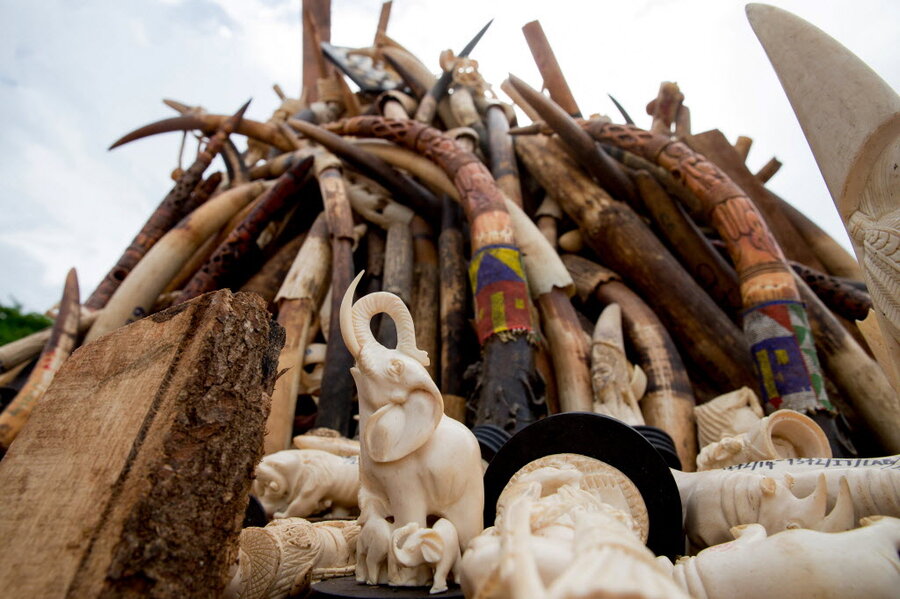5 approaches in effort to save Botswana's elephants
Loading...
According to an aerial survey covering 18 countries, the estimated population of Africa's savanna elephants is 352,271. Those figures show the population has decreased by about 30 percent between 2007 and 2014, and is continuing to decrease by 8 percent each year. Forest elephant populations are similarly in decline.
The decrease is largely due to poaching spurred on by the ivory trade. The aerial survey, funded by Microsoft co-founder and philanthropist Paul Allen, found 12 dead carcasses for every 100 live elephants, a rate high enough to have significant impacts on the population.
"Trade in ivory has been a driver of destabilization wherever it occurs in Africa," Allan Thornton, president of Washington's nonprofit Environmental Investigation Agency, told the Associated Press.
Researchers, wildlife organizations, and governments have come up with a variety of approaches to stabilize the dwindling elephant population in Africa and stop the ivory trade.
Domestic bans on ivory trade
The International Union for the Conservation of Nature World Conservation Congress is taking place in Honolulu from Sept. 1-10 and one of the main topics of discussion will be a domestic ban on the ivory trade.
Ivory trading is banned internationally, although most countries still allow trading within their borders. The movement to close domestic ivory markets completely, however, is gaining a great deal of support, partly because of commitments by US President Obama and Chinese President Xi Jinping to combat wildlife trafficking and in part because the trade poses a threat to national security and hinders economic development.
Relocation
Another approach is to relocate animals in danger from potential poaching or human encroachment to wildlife conservations. Earlier this summer in Malawi, 500 of elephants were relocated to a safer habitat in Nkhotakota Wildlife Reserve.
Critics have protested the practice since reintegrating animals can be traumatic and lead to the spread of disease. Many wildlife specialists, however, see this as a worthwhile practice for wildlife management.
"This is very much the way that we'll have to manage things in the future," Craig Reid, manager of Malawi's Liwonde National Park, which is run by African Parks, a nonprofit group based in Johannesburg, told the Associated Press. Mr. Reid described Liwonde, the park the elephants were evacuated from, as "an ecological island in a sea of humanity."
Fingerprinting
Researchers from King's College London, University College London, and London's Metropolitan Police have developed a technique to pull fingerprints from ivory in order to identify poachers. The trick was in finding a fine enough power that would adhere to the fingerprints left behind on the unusual surface.
"This is the first time that fingerprinting on ivory has been thoroughly investigated and a practical solution offered," Leon Barron, the study's author and a lecturer in forensic science at King's College London, said in a statement. "The only other study carried out over a decade ago simply showed that fingerprints were unstable and that the clarity of ridge detail was low, making it difficult to make reliable identifications."
DNA technology
Scientists have also devised a way to match DNA from ivory to the DNA from elephant dung to pinpoint where the majority of poaching is taking place.
Using this method, the researchers were able to pinpoint the poaching hotspots, including central African Tridom region that covers the Central African Republic, Gabon, and the Republic of Congo for forest elephant tusk and Tanzania and Mozambique for savanna elephants.
This information will make it easier for government agencies and wildlife organizations in Africa to monitor poaching in the region.
Tracing the origin of seized ivory is "a really critical piece of the puzzle," conservation biologist George Wittemyer of Colorado State University, Fort Collins, who was not involved in the study, told Science.
Emotional appeal
It worked for rhinos, it could work for elephants.
In Vietnam and China, where the supposed magical powers of powdered rhinoceros horn hold sway, Kenya-based African Wildlife Foundation and San Francisco-based WildAid recently launched public awareness campaigns in order to reduce the demand for rhino horn and thus make the poaching practice less economical.
"Advertisers will tell you that you win the heart and the mind follows," Peter Knights, executive director of WildAid told The Christian Science Monitor in January. "The point is to show that society has moved forward. If you're not there, you're behind the curve."








